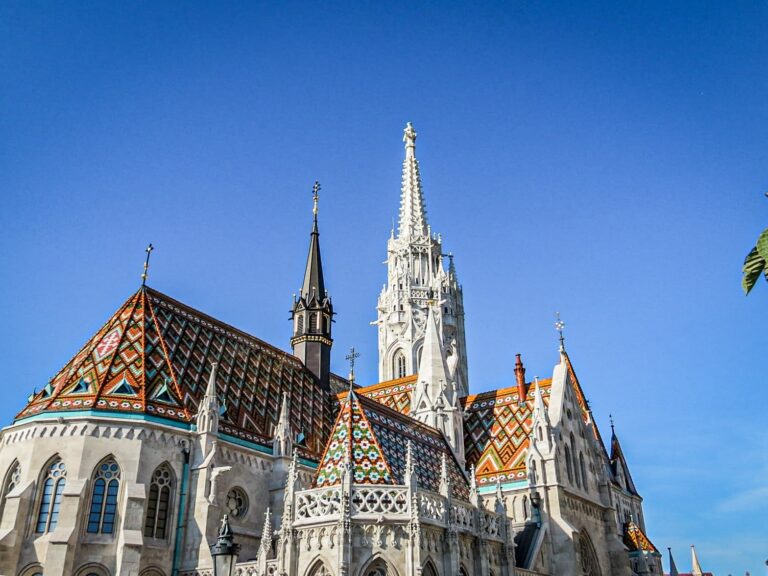What I Learned About College in the Baltic Countries
FREE INSIDER’S GUIDE

Top 5 English-Taught Colleges in Europe
Kickstart you education abroad with a powerful degree taught entirely in English, all without taking on any student loans!
I arrived in Vilnius, Lithuania to investigate college in the Baltic countries, after spending 10 days in Jordan with my son, Sam. I loved Jordan, which provided so many different sensory experiences. There were the sounds of the calls to prayer five times a day which I found soothing (except the one that happen before 5 am…). There were the smells of spices and grilled meat. There were amazing sights I could not have even imagined in Wadi Rum (the desert) and Petra (you may recognize it from Indiana Jones and the Last Crusade). There was the Frogger-like experience of crossing the street each time (even at crosswalks) and then there were the ups and downs of traveling with a teenager, which included good bonding conversations, as well as seemingly constant “advice” (not criticism I was told…).
Though the experience was absolutely incredible, I didn’t realize how much energy it took until I got to Vilnius. I was a bit grumpy when I arrived. I flew Ryan Air-which I always say I will never do again but then get sucked in by the low price. The boarding process reminds me of the old days with Southwest Airlines-sort of a mob mentality and then the flight attendants spend the entire flight peddling their goods. The person who came up with the idea to allow passengers to sample perfume in an enclosed space is not on my good list…We got to Vilnius late, and the cold fresh air when I walked out of the airport helped improve my mood almost immediately.
I had the weekend to explore the town before my meetings with a college in the Baltic countries began on Monday. I like visiting places in winter, as if you like a place as it’s worst weather wise, then you can imagine how great it would be at other times of the year. There are some places that felt depressing to me in the winter, like Sofia, Bulgaria and Warsaw, Poland. Though the skies are just as grey in Vilnius winters, I didn’t have that same feeling. “Hygge” is a Danish word, that has been entirely worn out internationally now, but really applies to Vilnius. The simplest way of describing it is a really cozy feeling. There are a ton of coffee shops with comfortable seating and lit in a certain way that make you want to go in with a book. There are wine bars-again with the warm lighting-with signs for mulled wine. The streets are clean, the architecture is beautiful, the people are friendly. I felt like I wanted to listen to classical music as I walked around the city (which is not something on any of my playlists). It just felt nice, and calm, and cozy.
Now, what I appreciate as a woman in my forties is very different than I would have liked as a college-aged student! This made me especially curious about student life in the city. I noticed that I didn’t see a lot of college-aged students out and about. Of course, it’s quite possible that the hours that I am out are not the hours in which college students are out (or awake). Certainly there are cafes, bars, nightclubs, theaters and more. It did get me thinking about the international student experience though.
One thing to note is that when a school reports their international student number or percentage, it includes all levels of study (bachelor’s, master’s, doctorate) AND almost always includes exchange students. This makes a huge difference! The international student percentage at Vilnius University, for instance is right around 9%. While that’s not a huge number, it’s not alarming. When you look at the percentage of degree seeking international students, however, it’s less than 3% and, again, that includes all levels of study!
So, why does this matter? For one thing, it can impact whether or not there are sufficient resources for international students. Vilnius University does not have an international student association or an international student office. They do offer an orientation week for international students (which includes exchange students) and they have an ESN office, but these are more directed at the exchange student experience. Further, one of the great benefits around studying in Europe is that students form friendships with people from all around the world. If half of your peer group leaves after just one semester, those meaningful bonds are harder to form and maintain.
Academically, Vilnius University has some strong programs and may be a good fit for some students. A student who is a little older may have the independence required to get their academic and social needs met. A student with a Lithuanian background may know enough of the language and culture to socially integrate with local students. These are just important considerations when looking at a school.
The international student population at Vilnius Technical University is similar to Vilnius University when you include exchange students, however it’s right around 5% when you look only at degree seeking students. It’s still small percentage, but they do have resources in place for their students. There is an office staffed with four people who work specifically with international degree students reading problems, questions, where to find resources, and more. Since they are a smaller university, they do this as the university level so all international students get the same information. There is an international coordinator in each academic department who helps students with the academic piece of things. They also have a mentor program for new degree seeking international students. Additionally, they reserve the newly renovated student residences for international students, which cost under 150 euros per month!
After recharging in Vilnius, I enjoyed the energy in Riga! It’s more urban, with people of all ages out and about at all times of day. It’s also remarkable beautiful with striking Art Nouveau architecture and abundant green space. Though the population is under 650,000 (similar to Portland, Oregon) it is the largest city in the Baltic region and, thus, provides an active night life. It’s an incredibly affordable city, even more so for students. For instance, students pay just 16 euros a month for an unlimited public transportation pass (the regular price is 50 euros). I really fell in love with Riga and it’s now on my list of favorite cities in Europe.
Of all the schools I visited on this trip, I was most excited by what I learned about Riga Technical University. Their total international student population is 15% which is at 10% when you subtract exchange students. The international student body is diverse, representing 87 countries. Not only does the university have an office that assists international students, but they also have an International Student Council which represents international student interests and arranges social events.
Unlike most universities in Europe, the university has a true campus, just a 25 minute walk (or 15 minutes by bus) from the city center. The campus houses the different academic departments, dorms (which cost 65-180 euros per month), and an Olympic size pool (there is a large recreation center off campus). There is a large shopping center directly next to the campus which includes a grocery store. The buildings were very well maintained, inside and out, which is not always the case with public universities.
Each program is split into groups of no more than 50 students for lectures with much smaller groups for labs and computer classes. Students are always taught by professors (not assistants) who are accessible for help outside of the classroom as well. All of the four year programs are very hands on, with lots of labs and internships in order to prepare students for the workforce. They evidently do a good job at this, given their strong reputation with employers. When I visit schools I look for strong academic programs and educational outcomes and an environment that supports international student life-academic and otherwise. Riga Tech checked all of these boxes.
My visits to the other schools in Riga helped me realize other questions students should ask when exploring a particular school or program. The majority of the international students in the other schools I visited are in just two programs (the integrated Medicine and Dentistry programs). There are only a handful of international students in each of the English-taught bachelor’s degree programs, and these students represent just a few countries. At one of these universities, classes for international students in the English-taught programs are separate from Latvians in the English-taught programs so it’s almost like private classes taught by the professors. While there is something to be said for the personalized attention in the classroom, I’m concerned about how isolating this would feel.
Though I absolutely love the Baltic area, I don’t think that Lithuania and Latvia are as far along with internationalization as Estonia is. That shouldn’t rule out the two countries for students. I would absolutely recommend Riga Tech, and there are certain types of students who the other schools may be a good fit for. More than anything, this trip helped me realize that there are some important questions students should look into when exploring a particular school or program. These are:
What is the number of degree seeking international students? How many countries are represented by the degree seeking international students? What is the percent of degree seeking international students in the program of interest? Is there an international student council?What types of international student associations are at the school? Is there an international student office at the university level? Do they work with degree seeking student exclusively or also exchange? Is there an international student coordinator at the program level? Is there a mentor/buddy program for international students?
After gathering that information, you can consider the impact each area would have on your own personal experience.






